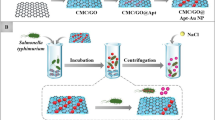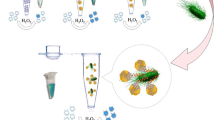Abstract
An aptamer-based assay is described for the determination of Salmonella typhimurium (S. typh). Carboxymethyl chitosan was loaded with amino-modified aptamer against S. typh, and then adsorbed on gold nanoparticles by electrostatic interaction to form a composite that acts as the molecular recognition element. In the presence of S. typh, it will be bound by the aptamer, and this changes the structure of the recognition element. On addition of salt solution, the gold nanoparticles agglomerate so that the color of the solution changes from red to blue. S. typh can be detected via measurement of the absorbance at 550 nm. Absorbance increases linearly with the logarithm of the S. typh concentration in the range from 100 to 109 cfu·mL−1. The limit of detection is 16 cfu·mL−1. The specificity and practicability of the assay were evaluated. The recoveries of S. typh from spiked milk samples are between 92.4 and 97.2%. The analytical results are basically consistent with those of a plate counting method.

Schematic representation of the colorimetric assay for Salmonella typhimuium (S. typh) using carboxymethyl chitosan (CMCS)-aptamer (Apt)-gold nanoparticles (AuNPs) composites.




Similar content being viewed by others
References
Dos Santos AMP, Ferrari RG, Conte-Junior CA (2018) Virulence factors in Salmonella Typhimurium: the sagacity of a bacterium. Curr Microbiol 284(18):1510–1514
Pang L, Zhang Z, Xu J (2011) Surveillance of foodborne disease outbreaks in China in 2006—2010. Chin J Food Hygi 23:560–563
Hu Y (2010) Investigation information for outbreak of Salmonella Typhimurium infection in United States from 2008 to 2009. MPM 37(10):1964–1965
Sharma TK, Bruno JG, Dhiman A (2017) ABCs of DNA aptamer and related assay development. Biotechnol Adv 35(2):275–301
Ruscito A, Smith M, GouDreau DN, Derosa MC (2016) Current status and future prospects for aptamer-based mycotoxin detection. J AOAC Int 99(4):865–877
Mondal B, Ramlal S, Lavu PSR, Murali HS, Batra HV (2015) A combinatorial systematic evolution of ligands by exponential enrichment method for selection of aptamer against protein targets. Appl Microbiol Biot 99(22):9791–9803
Moon J, Kim G, Park SB, Lim J, Mo C (2015) Comparison of whole-cell SELEX methods for the identification of Staphylococcus Aureus-specific DNA aptamers. Sensors 15(4):8884–8897
Wu P, Huang RX, Li GY, He YY, Chen CM, Xiao W, Ding P (2018) Optimization of synthesis and modification of ZnSe/ZnS quantum dots for fluorescence detection of Escherichia coil. J Nanosci Nanotechnol 18:3654–3659
Hasanzadeh M, Shadjou N, Guardia MDL (2017) Aptamer-based assay of biomolecules: recent advances inelectro-analytical approach. Trac-trend Anal Chem 89(12):119–132
Sharma A, Goud KY, Hayat A, Bhand S, Marty JL (2017) Recent advances in electrochemical-based sensing platforms for aflatoxins detection. Chemosensors 5(1):10001–10016
Cheng KY, Zhang JG, Zhang LP, Wang L, Chen HQ (2017) Aptamer biosensor for Salmonella typhimurium detection based on luminescence energy transfer from Mn2+-doped NaYF4:Yb, tm upconverting nanoparticles to gold nanorods. Spectrochim Acta A 171(12):168–173
Liu ZP, Su XG (2017) A novel fluorescent DNA sensor for ultrasensitive detection of Helicobacter pylori. Biosens Bioelectron 87(61):66–72
Abbaspour A, Norouz-Sarvestani F, Noori A, Soltani N (2015) Aptamer-conjugated silver nanoparticles for electrochemical dual-aptamer-based sandwich detection of staphylococcus aureus. Biosens Bioelectron 68(24):149–155
Zhang P, Liu H, Ma SZ, Men S, Li QZ, Yang X, Wang HN, Zhang AY (2016) A label-free ultrasensitive fluorescence detection of viable Salmonella enteritidis using enzyme-induced cascade two-stage toehold strand displacement-driven assembly of G-quadruplex DNA. Biosens Bioelectron 80(12):538–542
Zhang H, Ma XY, Liu Y, Duan N, Wu SJ, Wang ZP, Xu BC (2015) Gold nanoparticles enhanced SERS aptasensor for the simultaneous detection of Salmonella typhimurium and Staphylococcus aureus. Biosens Bioelectron 74:872–877
Huang Y, Cui L, Xue Y, Zhang S, Zhu N, Liang J, Li G (2017) Ultrasensitive cholesterol biosensor based on enzymatic silver deposition on gold nanoparticles modified screen-printed carbon electrode. Mat Sci Eng C-Mater 77:1–8
Kim YS, Raston NHA, Gu MB (2016) Aptamer-based nanobiosensors. Biosens Bioelectron 76:2–19
Lu L, Li K, Mao YH, Qu H, Yao B, Zhong WW, Ma B, Wang ZY (2017) Gold-chrysophanol nanoparticles suppress human prostate cancer progression through inactivating AKT expression and inducing apoptosis and ROS generation in vitro and in vivo. Int J Oncol 51:1089–1103
Liu YS, Du WP, Zheng KY, Fu LL, Chen M (2005) Comparative study on rapid dot-immunogold staining and two immunogold silver staining assays for diagnosing schistosomiasis japonica. Se Asian J Trop Med 36(1):79–82
Tanaka M, Saito Y, Misu H (2016) Development of a sol particle homogeneous immunoassay for measuring full-length selenoprotein pin human serum. J Clin Lab Anal 30(2):114–122
Wu SJ, Wang YQ, Duan N, Ma HL, Wang ZP (2015) Colorimetric aptasensor based on enzyme for the detection of vibrio parahemolyticus. J Agric Food Chem 63(35):7849–7854
He YY, Xiao W, Li GY, Yang F, Wu P, Yang T, Chen CM, Ding P (2019) A novel lead-ion-imprinted magnetic biosorbent: preparation, optimization and characterization. Environ Technol 40(4):488–507
He YY, Wu P, Xiao W, Li GY, Yi JC, He YF, Chen CM, Ding P, Duan YY (2019) Efficient removal of Pb(II) from aqueous solution by a novel ion imprinted magnetic biosorbent: adsorption kinetics and mechanisms. PLoS One. https://doi.org/10.1371/journal.pone.0213377
Bai Z, Li G, Liang J, Su J, Zhang Y, Chen H, Huang Y, Sui W, Zhao Y (2016) Non-enzymatic electrochemical biosensor based on Pt NPs/RGO-CS-fc nano-hybrids for the detection of hydrogen peroxide in living cells. Biosens Bioelectron 82:185–194
Mokhtarzadeh A, Tabarzad M, Ranjbari J, Guardia MDL, Hejazi M, Ramezani M (2016) Aptamers as smart ligands for nano-carriers targeting. Trends Anal Chem 82:316–327
Ma XY, Song L, Zhou NX, Xia Y, Wang ZP (2017) A novel aptasensor for the colorimetric detection of S. typhimurium based on gold nanoparticles. Int J Food Microbiol 245(24):1–5
Xu XM, Ma XY, Wang HT, Wang ZP (2018) Aptamer based SERS detection of Salmonella typhimurium using DNA-assembled gold nanodimers. Microchim Acta 185(7):325
Zhang P, Liu H, Li XC, Ma SZ, Men S, Wei H, Cui JJ, Wang HN (2017) A label-free fluorescent direct detection of live Salmonella typhimurium using cascade triple trigger sequences-regenerated strand displacement amplification and hairpin template-generated-scaffolded silver nanoclusters. Biosens Bioelectron 87:1044–1049
Guo RY, Wang SY, Huang FC, Chen Q, Li YB, Liao M, Lin JH (2019) Rapid detection of Salmonella Typhimurium using magnetic nanoparticle immunoseparation, nanocluster signal amplifcation and smartphone image analysis. Sensors Actuators B Chem 284:134–139
Wang SY, Zheng LY, Cai GZ, Liu N, Liao M, Li YB, Zhang XB, Lin JH (2019) A microfluidic biosensor for online and sensitive detection of Salmonella typhimurium using fluorescence labeling and smartphone video processing. Biosens Bioelectron 140:111333
Wang XL, Niazi S, Huang YK, Sun WJ, Wu SJ, Duan N, Hun X, Wang ZP (2017) Homogeneous time-resolved FRET assay for the detection of Salmonella typhimurium using aptamer-modified NaYF4: Ce/Tb nanoparticles and a fluorescent DNA label. Microchim Acta 184:4021–4027
Duan N, Wu SJ, Zhu CQ, Ma XY, Wang ZP, Yu Y, Jiang Y (2012) Dual-color upconversion fluorescence and aptamer-functionalized magnetic nanoparticles-based bioassay for the simultaneous detection of Salmonella Typhimurium and Staphylococcus aureus. Anal Chim Acta 723:1–6
Hu J, Jiang YZ, Tang M, Wu LL, Xie HY, Zhang ZL, Pang DW (2018) Colorimetric-fluorescent-magnetic nanosphere-based multimodal assay platform for Salmonella detection. Anal Chem. https://doi.org/10.1021/acs.analchem.8b05154
Acknowledgments
This work was supported by research grants from the National Natural Science Foundation of China (grant number 21676305) and the Fundamental Research Funds for the Central Universities of Central South University (grant number 2019zzts744).
Author information
Authors and Affiliations
Corresponding authors
Ethics declarations
The author(s) declare that they have no competing interests.
Additional information
Publisher’s note
Springer Nature remains neutral with regard to jurisdictional claims in published maps and institutional affiliations.
Electronic supplementary material
ESM 1
(DOC 5457 kb)
Rights and permissions
About this article
Cite this article
Yi, J., Wu, P., Li, G. et al. A composite prepared from carboxymethyl chitosan and aptamer-modified gold nanoparticles for the colorimetric determination of Salmonella typhimurium. Microchim Acta 186, 711 (2019). https://doi.org/10.1007/s00604-019-3827-5
Received:
Accepted:
Published:
DOI: https://doi.org/10.1007/s00604-019-3827-5




